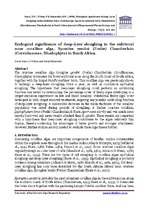Ecological significance of deep-layer sloughing in the eulittoral zone coralline alga, Spongites yendoi (Foslie) Chamberlain (Corallinaceae, Rhodophyta) in South Africa.
Abstract
The crustose coralline alga Spongites yendoi (Foslie) Chamberlain (Corallinaceae, Rhodophyta) dominates the lower eulittoral zone along the South Coast of South Africa, together with the limpet Patella cochlear Born. This coralline alga was previously shown to undergo a deep-layer sloughing twice a year, as well as continuous epithallial sloughing. The hypothesis that deep-layer sloughing could perform an antifouling function was tested by determining the percentage cover of fleshy algae developing in a limpet exclusion experiment on live and killed coralline. Substantial fleshy algal cover developed in both limpet removal treatments, negating any possible antifouling function of deep-layer sloughing. A measurable decrease in the mean thickness of the coralline population was noted during periods of sloughing. A thicker crustose coralline, Leptophytum ferox (Foslie) Chamberlain & Keats, grew more slowly and was much more heavily burrowed and more weakly attached than S. yendoi. These results are consistent with a hypothesis that deep-layer sloughing contributes to the alga's relatively thin thallus, thereby conferring the advantages of faster growth and stronger attachment. However, further studies are still needed to evaluate these hypotheses further.

